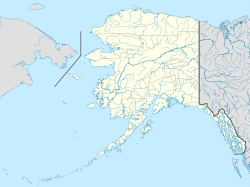Marks Air Force Base is a former United States Air Force facility located two nautical miles (4 km) west of the central business district of Nome, a city in the Nome Census Area of the U.S. state of Alaska.[1] It was named in honor of Major Jack S. Marks, a United States Army Air Forces pilot based at Ladd Army Airfield who died when his aircraft was shot down over the Aleutians in July 1942.[2] Following its closure, it was redeveloped into Nome Airport.
Marks Air Force Base | |||||||||||||||
|---|---|---|---|---|---|---|---|---|---|---|---|---|---|---|---|
 | |||||||||||||||
| Summary | |||||||||||||||
| Airport type | Military | ||||||||||||||
| Owner | United States Air Force | ||||||||||||||
| Location | Nome, Alaska | ||||||||||||||
| Elevation AMSL | 38 ft / 12 m | ||||||||||||||
| Coordinates | 64°30′44″N 165°26′43″W / 64.51222°N 165.44528°W | ||||||||||||||
| Map | |||||||||||||||
 | |||||||||||||||
| Runways | |||||||||||||||
| |||||||||||||||
History
editIn World War II, the civilian Nome Airport shared use of the runway with Marks Army Airfield for transfer of Lend-Lease aircraft to the Soviet Union and in 1942, for air defense of the western coast of Alaska. Marks AAF units included the 404th Bombardment Squadron (July 18–28, 1942) of the 28th Bombardment Group and the 56th Fighter Squadron (June 20 – October 20, 1942) of the 54th Fighter Group. On August 15, 1947, the Arctic Indoctrination Survival School (colloquially known as "Cool School") was formed at Marks Army Air Base.[3]
Renamed Marks Air Force Base in 1948, the military installation was used as a fighter-interceptor forward base until they were pulled back to Galena Airport. Marks AFB closed in 1950 and an air base squadron was at Nome Airport until December 1956.
Facilities and aircraft
editMarks Air Force Base resided at elevation of 38 feet (11 m) above mean sea level. It has two runways with asphalt surfaces: Runway 10/28 is 6,000 by 150 feet (1,829 x 46 m) and Runway 3/21 is 6,175 by 150 feet (1,882 x 46 m).[1]
See also
editReferences
edit- ^ a b c FAA Airport Form 5010 for OME PDF. Federal Aviation Administration. Effective May 31, 2012.
- ^ "The World War II Heritage of Ladd Field, Fairbanks, Alaska" (PDF). Fort Collins, Colorado: Center for Environmental Management of Military Lands. May 2004. p. 24. Retrieved November 8, 2022.
- ^ (Hist, AAC, 1946-1947, p. 94; Maxwell, Hist, AAC, 1948, p. 59.) http://www.alaskawingcaf.org/Alaska%20Heritage/August%2013-19.pdf "under the leadership of Capt Harold W. Strong. Plans called for it to be manned by 9 officers and 42 enlisted with the students limited to 60 a week. The training was directed to air crews with subjects taught on survival on sea ice and tundra."
Other sources
edit- This article incorporates public domain material from the Air Force Historical Research Agency
- Maurer, Maurer (1983). Air Force Combat Units Of World War II. Maxwell AFB, Alabama: Office of Air Force History. ISBN 0-89201-092-4.
- Maurer, Maurer (1969), Combat Squadrons of the Air Force, World War II, Air Force Historical Studies Office, Maxwell AFB, Alabama. ISBN 0-89201-097-5.
